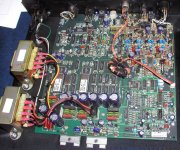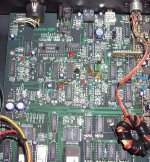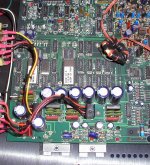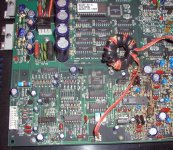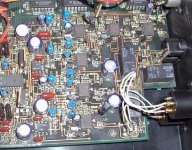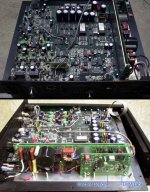Dear friends,
Could you provide me your opinion/info on that old product?
The new Mr. Meitner site is www.emmlabs.com
His patents are there:
http://patft.uspto.gov/netacgi/nph-...s1='5329556'.WKU.&OS=PN/5329556&RS=PN/5329556
http://patft.uspto.gov/netacgi/nph-...1&S1=5404362.WKU.&OS=PN/5404362&RS=PN/5404362
http://patft.uspto.gov/netacgi/nph-...1&S1=5388221.WKU.&OS=PN/5388221&RS=PN/5388221
http://patft.uspto.gov/netacgi/nph-...1&S1=5499315.WKU.&OS=PN/5499315&RS=PN/5499315
Could you provide me your opinion/info on that old product?
The new Mr. Meitner site is www.emmlabs.com
His patents are there:
http://patft.uspto.gov/netacgi/nph-...s1='5329556'.WKU.&OS=PN/5329556&RS=PN/5329556
http://patft.uspto.gov/netacgi/nph-...1&S1=5404362.WKU.&OS=PN/5404362&RS=PN/5404362
http://patft.uspto.gov/netacgi/nph-...1&S1=5388221.WKU.&OS=PN/5388221&RS=PN/5388221
http://patft.uspto.gov/netacgi/nph-...1&S1=5499315.WKU.&OS=PN/5499315&RS=PN/5499315
bidat
I know, that Meitner IDAT uses a DSP-chip-based digital filter for continuous signals. This filter produces a normal squarewave shape, but switches to a filter algorithm optimized for transient performance on signals that are rich in transients.
But maybe somebody knows what receiver, DACs and symmetrical output stage were used?
I know, that Meitner IDAT uses a DSP-chip-based digital filter for continuous signals. This filter produces a normal squarewave shape, but switches to a filter algorithm optimized for transient performance on signals that are rich in transients.
But maybe somebody knows what receiver, DACs and symmetrical output stage were used?
I'm using the Museatex Meitner Bidat with the Melior CD-D with full modifications from Museatex. (The Bidat allegedly replaced and bested the Idat at a far lower price.)
I find the sound to be on par with that I've heard from top of the line gear from DCS, Linn, Meridian, and ML.
I have yet to pop open the Bidat, but will be doing so soon to add dampening materials. Hence, I can't address your specific questions. My understanding is the Bidat employs proprietary adaptive algorithms chosen on the fly.
John Wright at Museatex might prove helpful...
(My Bidat and Transport are on a Vibraplane with multiple stages of power filtration.)
I find the sound to be on par with that I've heard from top of the line gear from DCS, Linn, Meridian, and ML.
I have yet to pop open the Bidat, but will be doing so soon to add dampening materials. Hence, I can't address your specific questions. My understanding is the Bidat employs proprietary adaptive algorithms chosen on the fly.
John Wright at Museatex might prove helpful...
(My Bidat and Transport are on a Vibraplane with multiple stages of power filtration.)
Comparing to ML360S, the sound is more listenable and involving, more musical as some may say. It has a bit less refinement, but overall I would prefer Bidat.
My unit isn't modified, although it has Supermod done. That DAC certainly needs modifications to achieve full potential..
My unit isn't modified, although it has Supermod done. That DAC certainly needs modifications to achieve full potential..
dimitri said:Thank you, Peter! The receiver is SAA7274 and digital filter is SAA7350. Is it correct? I noticed two (!) Motorola processors.
Yes, that is correct. Email me for higher res pics.
dimitri said:Thank you, Peter! The receiver is SAA7274 and digital filter is SAA7350. Is it correct? I noticed two (!) Motorola processors.
The two DSP56002 form the digital filter and the SAA7350/TDA1547 combination make up the Bitstream dac. The SAA7350 is capable of operating as a dac on its own.
rfbrw said:We don't want no NOSsers in this here town.
As you see, I do my best to stay in town
Peter Daniel said:
As you see, I do my best to stay in town
The ownership of a meitner Bidat, a device as far removed from the NOS cult as possible, gives you special dispensation to remain in town.
Peter Daniel said:Here are some pics of the Bidat
Wow. That appears to be an early BiDat.
Mine has a switching PS labeled EMM Labs. And overall the interior of mine looks more profesionally finished.
It seems the complexity of the BiDAT is kinda' the polar opposite of your DAC, Peter.
-Rob
Peter Daniel said:From what I've read, switching PS is not really recommended for that DAC. Is the layout of your board different?
Ed Meitner is one of the few I'd trust to properly implement a SMPS in an audio device. But still...
Shot some pics of the guts of my BiDAT. EEPROMS say Rev. 1.5b.
Attachments
dimitri said:Thank you, Peter! The receiver is SAA7274 and digital filter is SAA7350. Is it correct? I noticed two (!) Motorola processors.
The BIDAT, or Baby IDAT has two processing algorithms which are chosen on the fly. Ed Meitner developed DSD for Sony. He did it in a few months. Speculation is it would have taken Sony several floors worth of EEs working for years to accomplish what Ed did in mere months.
http://www.museatex.com/bidatman.htm
From the manual (circa mid 90's):
"At the heart of the Museatex Bidat is a unique and proprietary digital filter algorithm which processes digital audio information using two DSP microprocessors. As the name implies, this algorithm examines the digital audio data and makes an intelligent determination on how best to up sample this data to an eight times over sampled rate (8Fs, 352.8KHz for CD) while maintaining unequaled faithfulness to the sounds originally recorded.
Other manufacturers who have designed their own digital filters have mostly used algorithms similar to the textbook topologies found in the commonly available filter IC's. A few have made attempts to optimize their filters by concentrating on transient response accuracy and have done so by sacrificing their frequency response.
There are other designs which claim optimization of both time and frequency responses but nonetheless exhibit audio artifacts similar to those produced by the standard mass-market filter IC's; principally a symmetrical ringing at 1/2Fs which occurs before and after each transient and is known as Gibb's Phenomenon
The Bidat algorithm analyzes the digital audio samples for relative accelerations and then chooses the type of filter most appropriate for that segment of data. This intelligent process results in a frequency response which is flat to 20KHz for CD playback. More important, it produces a uniquely pure impulse response without Gibb's ringing. For example, a square wave will have clean rectangular transitions and no ringing.
The Museatex Bidat can claim transient response demonstrably MORE faithful to the recorded signal than the best analog playback systems for vinyl LP's and open-reel tapes. The undistorted transient response of the Bidat means the algorithm contributes no coloration of its own to the processed audio. This performance eliminates the "digital washout" of sonic subtleties and the harshness heard in listening to a conventional interpolating algorithm. For the first time in audio engineering, the full advantage of Digital Signal Processing has been used in the service of signal fidelity by the implementation of a smart filter which could never have been built with analog circuits."
-Rob
Peter Daniel said:I will be heavily modifying that unit soon, to hopefuly bring its certain performance aspects closer to what I'm used to with NOS TDA1543 DAC
Short of running it over with a steamroller, I can't see how you can make it sound that bad.
- Status
- This old topic is closed. If you want to reopen this topic, contact a moderator using the "Report Post" button.
- Home
- Source & Line
- Digital Source
- BiDAT/Meitner/MuseaTex/
